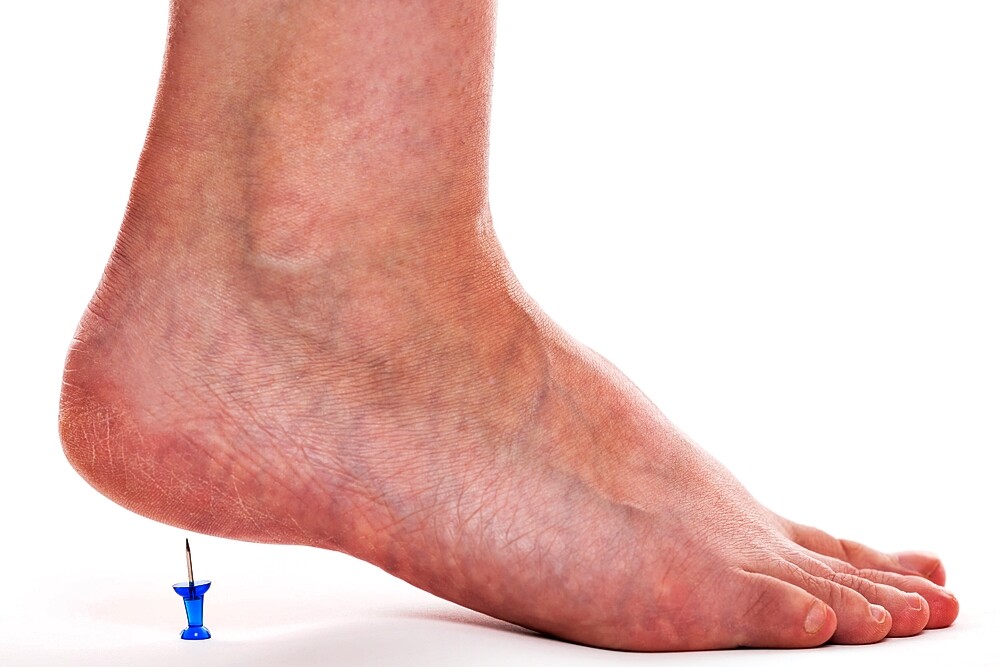It feels as if you step on a nail, every step hurts: a heel spur can be very unpleasant. But there are some treatment options – and exercises for at home.
What’s a heel spur?
Heel spur (also called calcaneal spur) is a bony outgrowth on the heel. Doctors differentiate between the upper heel spur, where the Achilles tendon attachment to the heel bone is affected. And the lower heel spur (plantar heel spur), where the plantar tendon running along the sole of the foot is affected.
Heel spur: Origin and possible causes
A heel spur develops over a longer period of time, often people between 40 and 60 years of age are affected. Poor footwear, heavy strain due to sports, or overweight can permanently put a lot of strain on the muscle tendons of the heel bone, resulting in small cracks. The strain can then lead to inflammation. The body tries to counteract this by depositing calcium at the site. This in turn gradually ossifies and becomes a heel spur.
Other risk factors include foot malpositions (such as fallen arches or hollow feet), tendosynovitis and frequent prolonged standing or walking.
Symptoms of heel spur
Stinging or burning pain occurs when walking. In addition, foot pain often occurs after a longer period of rest, e.g. in the morning after getting up (also called tarnishing pain). If a heel spur is suspected, it is advisable to consult a doctor immediately in order to avoid chronic complaints in the first place.
Heel spur on the foot: Tips and home remedies
In an acute situation, these tips and home remedies that you may already have at home can help you with pain:
- Avoid intensive stress (such as competitive sports) in the case of foot pain
- Wear comfortable shoes that do not constrict.
- Put cool packs on, but not directly on the skin! Either wrap the cool pack in a cloth or place the cloth on the skin so that it lies between the skin and the cool pack.
- Apply an anti-inflammatory gel for relief.
- You can also wear a heel cushion (upper heel spur) or, if you have a lower heel spur, get insoles for your shoes that have a recess, i.e. a hole, to relieve the foot.
Treatment of a calcaneal spur (heel spur)
The healing of a calcaneal spur usually requires long-term therapy, it can take several weeks or months until the symptoms disappear. Your doctor will determine the most suitable treatment for you. These are the usual methods:
Shock waves
In shock wave therapy, pressure waves are applied to the heel spur using a device. These shock waves are intended to stimulate blood circulation and cell metabolism and to heal the inflammation more quickly.
X-rays
Here, the heel spur is irradiated with a low dose over several weeks. However, the patient should be aware that he is exposed to radiation, albeit in low doses.
Physiotherapy
Physiotherapy can also promote healing with its special stretching and strengthening exercises. The large tendon plate (plantar fascia), as well as the Achilles tendon and the calf muscles are stretched. The patient can continue the exercises at home.
Operation
An operation is now performed rather rarely. A one hundred percent cure is therefore not certain, and it is also associated with risks. And: a new heel spur can also form.
Heel spur: Stretching exercises
If you have acute heel pain or want to prevent a heel spur, the following four exercises can help you:
- Sit on the edge of the bed or a chair and now roll back and forth with the sole of your foot for a few minutes with a tennis ball.
- Hold on to a chair back and take a big step backwards with the affected foot. The front leg is bent. Now shift your body downwards to the front so that the rear (stretched) leg is pulling. Hold this position for about 20 seconds.
- Sit on the floor with your legs stretched out. Now place a gymnastics band or a rolled up towel around your foot. Now pull it carefully towards you with the tape, hold it for about 30 seconds.
- For this exercise you need a staircase: Stand on a step so that your heels protrude, i.e. hang in the air. Hold on to the railing! Now slowly lower your heels and hold them for 20 to 30 seconds.
You should do these exercises about two to three times a day.

